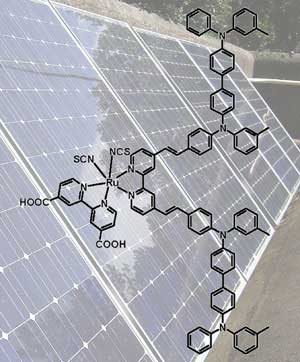| Posted: April 26, 2007 |
Super solar cells |
|
(Nanowerk News) Supramolecular dyes could boost efficiency in solar cells, say scientists from the UK.
|
|
Saif Haque, from Imperial College, London, found that supramolecular dyes gave a 25% improvement in performance as compared to conventional, non-supramolecular dyes ( "Reducing charge recombination losses in solid state dye sensitized solar cells: the use of donor–acceptor sensitizer dyes").
|
 |
|
Dye-sensitized solar cells typically consist of a dye-sensitised titania film and an organic semiconductor that transports positive 'holes'. The dye absorbs light and an excited electron is transferred from the dye to the conduction band of the titania. The dye then regains an electron from the semiconductor. The device performance depends on the efficiency of this charge recombination. Haque has found that supramolecular dyes improve the efficiency of solar cells by controlling the charge recombination between photo-injected electrons and the oxidised semiconductor.
|
|
'The field of supramolecular chemistry is well advanced but the application of such materials in solar cells to yield high efficiencies is yet to be realized,' explained Haque. 'A key issue holding this back is lack of quantitative structure-function relationships that enable rational design of supramolecular electronic materials,' he said.
|
|
Haque thinks that this work may also prove useful for different applications. 'A key feature of the work is the achievement of long-lived charge separated states using supramolecular dye structures. Long-lived charge separation is also important for applications such as light driven hydrogen evolution from water, or new optical data storage devices based upon long-lived charge separated states,' he said.
|
|
Masao Kaneko, of Ibaraki University, Mito, Japan said that this strategy could lead to further advances. 'Dye-sensitized solar cells are attracting a great deal of attention as the next generation solar cell. The research group has had success in significantly reducing charge recombination losses. One could expect further improvement in conversion efficiency of dye-sensitized solar cells using this strategy.'
|

